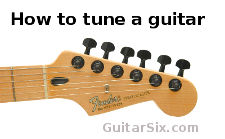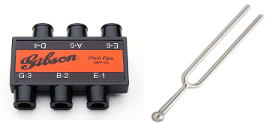How To Tune A Guitar

How to tune a guitar is probably one of the most important tasks every beginning guitarist should practice. It's important to always play guitar with a properly tuned instrument and it takes time to learn how to do it. I present here, various methods on how to tune the guitar to standard tuning.
Looking for my guitar tuner?Standard tuning means your guitar is tuned to (from lowest to highest strings) E A D G B E. In standard tuning, the strings are tuned in intervals of a 4th (the distance apart from each other) with the exception of the 2nd string which is an interval of a 3rd apart from the 3rd string. Standard tuning is also based around the pitch of A440 which is considered concert pitch. A440 is the note A above middle C that has a frequency of 440 Hz.
Electronic tuners
The easiest method to tune your guitar is having someone else do it for you...just kidding...well not really. Using an electronic tuner is kind of like having someone else tune your guitar. Did you know, there are actually robotic guitar tuners on the market that do tune your guitar for you? I won't get into those here though.
Using an electronic tuner basically involves playing a string and watching a screen of some sort that displays the strings current pitch. Then all you have to do is turn your guitar's tuning peg until the screen reads the correct pitch or get arrows or lines to line up. That is all there is to it. No listening required.

Which electronic tuners is best
There are various models of electronic tuners out there. There are tuners that you plug into your guitar and some that you don't. Some are integrated into amplifiers, pedals and other effects. Some like the one pictured above clip onto the guitar head stock. Heck they even make guitar tuner apps for your phone! All of them work about the same and which one is best is the one that is easiest for you to use.
Tuning using reference tones
Tuning using reference tones is another common way to tune your guitar. A reference tone is a tone played on another device or in tune instrument that you make your instrument match using your ears (you want to develop your ears don't you?). You can use other guitars, pianos, human voice or devices like pitch pipes or tuning forks to get reference tones. You can even use your own guitar as long as it has at least one string in tune.
Below is a picture of a Gibson guitar pitch pipe and an A440 tuning fork.

Pitch pipes work much like a whistle, you blow into the holes and the specified tone comes out. Pitch forks are struck and then they ring with whatever pitch they are.
How do you make a tone on your guitar match a reference tone?
How do you make two tones match?
This is a good question you may have already asked yourself. Making the two tones match requires a listening skill you must develop. You can only develop this skill through practice and trial and error.
What it comes down to is this:
Sounding your reference tone while turning your guitar's tuning key - then ...
GET RID of the WARBLE.
When the two tones don't match there is a warble like effect between them. The closer the two tones come to each other in pitch, the stronger the warble effect. When two tones are the same, they hum in a perfect synchronicity that is unmistakable. That is how you know when the two match.
How to tune a guitar to itself
You might be wondering how to tune a guitar to itself. If you have at least one string in tune, you can use it as a reference tone to tune all the other strings. If you don't have a string in tune, use a reference tone or tuner to get one (step 1) then follow the steps 2-6 below to tune the rest of the guitar strings. Use the below graphic as a guide as you read the steps.

1) Lets pretend you don't have any strings that are tuned. Get another guitar that is in tune and pluck the A string to use as your reference tone. Tune your A string by turning your tuning key to so that the pitch of your A string matches the other guitar's A string.
Here is an A string sound you can use as a reference tone.
2) Tune the 6th string to the 5th string by pressing down the note at the 5th fret (on the 6th string) and simultaneously play it and the 5th string. Make the pitch on the 5th fret 6th string match the pitch of the 5th string.
3) Tune the 4th string to the 5th string by pressing down the note at the 5th fret (on the 5th string) and simultaneously play it and the 4th string. Make the pitch on 4th string match the pitch of the 5th string fretted at the 5th fret.
4) Tune the 3rd string to the 4th string by pressing down the note at the 5th fret (on the 4th string) and simultaneously play it and the 3rd string. Make the pitch on 3rd string match the pitch of the 4th string fretted at the 5th fret.
5) Tune the 2nd string to the 3rd string by pressing down the note at the * 4th fret (on the 3rd string) and simultaneously play it and the 2nd string. Make the pitch on 2nd string match the pitch of the 3rd string fretted at the 4th fret. * note that you fret the 4th fret in this step all other steps fret the 5th fret.
5) Tune the 1st string to the 2nd string by pressing down the note at the 5th fret (on the 2nd string) and simultaneously play it and the 1st string. Make the pitch on 1st string match the pitch of the 2nd string fretted at the 5th fret.
Tuning with octaves at the 7th fret

The octaves method to tune is similar to the the previous method of tuning the guitar to itself but uses the octaves (a pitch an order higher) at the 7th fret (or 8th on the 2nd string) to tune. This method is slightly more difficult for beginners because using octaves to tune requires you to determine the same tones but with one being an octave higher in pitch. The note's pitch at the 7th fret (or 8th on the 2nd) is the same as the string below but one octave higher.
How to tune a guitar with harmonics
You can tune a guitar to itself using harmonics as long as it has either the 6th or 5th string already in tune. This method will work even if you don't have one of those strings tuned but the guitar as a whole will not be tuned to concert pitch.
A harmonic is when you lightly touch the string above a fret to produce a bell like sound. It just so happens that there are harmonics at the 5th and seventh frets that are easy to use for tuning. Here are the list of harmonic notes you can use to tune each string:

In the graphic above the letter names of the stars are the note names of the harmonic pitch produced not the note name of the fret. Starting from the 6th string, tune the next string up following this list of harmonic notes that are the same. For example: consider the first one on the list - make the 5th string harmonic at the 7th fret sound the same as the harmonic on the 6th string 5th fret.
* E 6th string 5th fret harmonic is same harmonic note as E 5th string 7th fret.
* A 5th string 5th fret harmonic is same harmonic note as A 4th string 7th fret.
* D 4th string 5th fret harmonic is same harmonic note as D 3rd string 7th fret.
* B 6th string 7th fret harmonic is the same note as B 2nd string OPEN.
* E 5th string 5th fret harmonic is the same note as E 1st string OPEN.
Alternate tuning
So far I've only described tuning in standard tuning. However you might want to explore alternate tuning as you continue to learn more about guitar. There are many alternative ways to tune a guitar. I'm not going to talk too much about them here but I just wanted to list a few to tickle your curiosity.
Drop D tuning - same as standard tuning but with the low E string tuned even lower to a D.
Drop C tuning - same as Drop D but uses an even lower C note for the lowest string.
Drop B tuning - B-F#-B-E-G#-C#
Half step down - Tune all strings one half step lower. Eb Ab Db Gb Bb Eb -- See the guitar tuner page for half step down reference tones.
Full step down - Tune all strings one full step lower. D G C F A D
In summary
I hope this article has helped you learn about tuning a guitar. Getting good at tuning takes time and practice so stick with it. Someday, you will be able to tune any guitar by ear alone. It's a valuable skill to have and people will be in awe when they see you do it.
Posted July 22, 2015, 11:33 pm in: Beginner guitar lessons
Share a link to this guitar lesson with your friends (right click Permalink > copy or mobile long press > copy)




 loading
loading